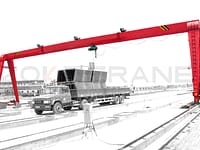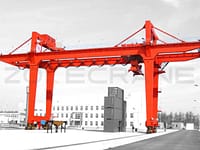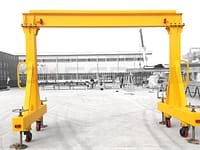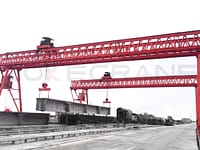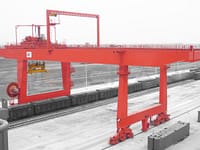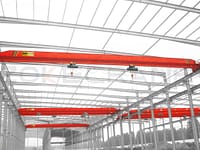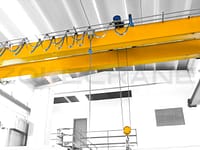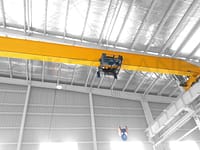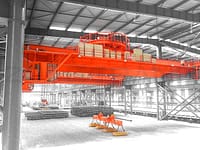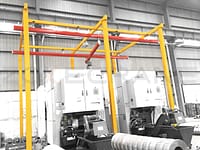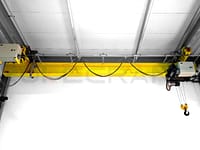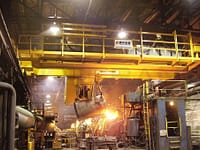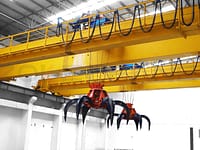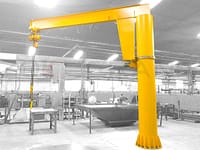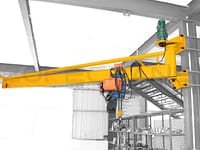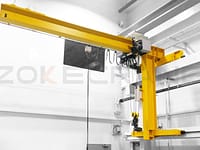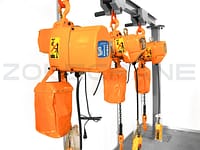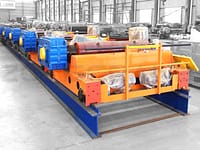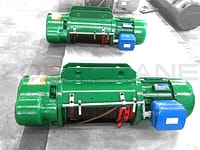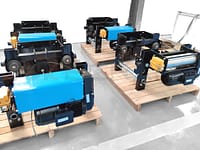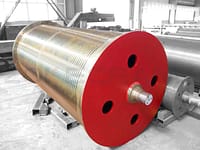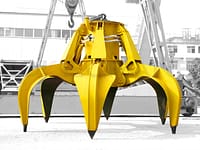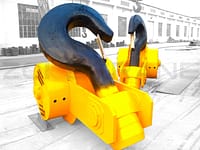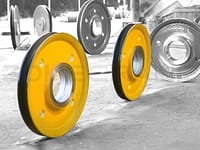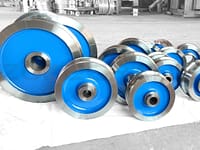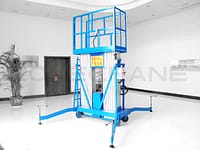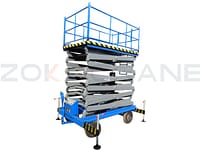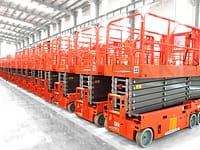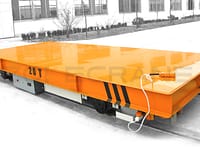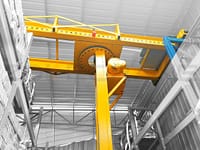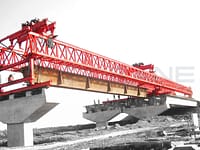What is the safe working load of crane
The safe working load of a crane is the maximum weight that a crane can safely carry when it is designed or manufactured. This weight limit is designed to ensure safe crane operation and prevent accidents caused by overloaded operation. This is determined with consideration of various factors and criteria to ensure that the crane can maintain stability and safety during operation. Safe working load is one of the key parameters in the design and use of cranes, which ensures the safety of the operator and equipment.
Wikipedia definition
The Safe Working Load (SWL), sometimes referred to as the Normal Working Load (NWL), is the maximum safe force that can be exerted by a lifting equipment, lifting device, or attachment when lifting, suspending, or lowering a given mass without fear of rupture. It is usually marked on the equipment by the manufacturer. It is the result of dividing the Minimum Breaking Strength (MBS), also known as the Minimum Breaking Load (MBL), by a factor of safety, which is usually between 4 and 6 for lifting equipment. If the equipment poses a threat to human life, the safety factor can be as high as 10:1 or 10 to 1.
The Working Load Limit (WLL) is the maximum working load designed by the manufacturer. The force represented by this load is much less than the force required to cause the lifting equipment to fail or yield. the WLL is calculated by dividing the MBL by the Safety Factor (SF). For example, if a safety factor of 5 (5:1, 5 to 1, or 1/5) is used, then the SWL or WLL for a chain with a primary load of 2000 lbf (8.89 kN) would be 400 lbf (1.78 kN).
The current U.S. Standard for Lifting and Handling Equipment is reference (1), which specifies ASME B30.20 Minimum Structural and Mechanical Design and Electrical Component Selection Criteria for Underhook Lifting Equipment. The provisions of this standard are applicable to the design or modification of below-the-hook lifting appliances.
Therefore:
WLL = MBL / SF
SWL standards are no longer used to determine the maximum load capacity of equipment because they are too vague and prone to legal problems. American and European standards switched to the "Working Load Limit" criterion shortly thereafter.
How to calculate the safe working load of cranes
The load acting on the crane is divided into three categories, namely: basic load, additional load and special load.
1. Basic load
Basic load refers to always or often act on the crane structure load, including deadweight load, lifting load, inertia level load, as well as the consideration of dynamic load coefficients (l, 2, 4) and the corresponding static load multiplied by the dynamic load effect. For some cranes with grabs (bins) or electromagnetic disk operation, should be considered as a result of sudden unloading of the hoisting load generated by the dynamic load-shedding effect.
2. Additional load
Additional load refers to the crane in the normal operating conditions of the structure by the non-recurrent role of the load. Including the maximum wind load acting on the structure of the crane in working condition, the lateral force of the crane skew operation, as well as according to the actual situation decided to consider the temperature load, snow and ice load and some process loads.
3. Special load
Special load refers to the crane in the non-working state, the structure may be subjected to the maximum load or in the working state of the structure occasionally subjected to unfavorable loads. The former, such as the structure is subject to non-working state of the maximum wind load, test loads, as well as according to the actual situation decided to consider the installation of loads, seismic loads and certain process loads, etc.; the latter, such as the crane in the working state of the collision loads and so on.
- Only consider the basic load combination for the combination I.
- Considering the combination of basic load and additional load as the combination Ⅱ.
- Consider the basic load and special load combination or three types of loads are combined for the combination of Ⅲ.
Various types of load combinations are the original basis for structural strength and stability calculations, and the safety coefficients of strength and stability must be satisfied with the specified values of the three types of load combinations I, III and III, and the fatigue strength is only calculated according to the load combination I.

Note:
1. For combination Ⅱ, the effect of wind on startup (braking) time should be taken into account when calculating PH2.
2. Combination Ⅲa can also be used for installation conditions, at this time PG according to the installation design, PW, 0 for the installation wind load.
3.Pdt
Basic principles of calculation
In order to ensure that the crane safe and normal work, its metal structure and mechanism of the components should meet the requirements of strength stability and stiffness. Strength and stability requirements refers to the structural components in the load generated by the internal force should not exceed the permissible bearing capacity (refers to the strength, fatigue strength and stability of the permissible bearing capacity); Stiffness requirement means that the deformation produced by the structure under the action of load should not exceed the permissible deformation value, and the self-oscillation period of the structure should not exceed the permissible vibration period.
Crane components and metal structures should be the following calculations: ① fatigue, wear or heat calculation:② Strength calculation; ③ Strength check. With these three types of calculations, the crane's calculated load has the following three combinations:
- Life (durability) calculation load a Class I load. This load is used to calculate the durability, wear and tear or heat generation of parts or metal structures. Calculated according to the equivalent load in normal operation, not only calculate the size of the load, but also take into account their time of action.
For institutional parts and metal structures subjected to variable loads, fatigue calculations should be performed when the number of stress change cycles is sufficiently high; fatigue calculations are not necessary when the number of stress change cycles is low or very low. Work level is A6, A7, A8 level crane metal structure components and institutional parts should be tested fatigue. - Strength calculation load a class II load. This type of load is used to calculate the strength of parts or metal structure, compression and plane bending components of stability, rigidity of structural components, the overall stability of the crane and wheel pressure, according to the maximum load of the working state for strength calculation. Determine the strength calculation load, should be selected as the most unfavorable combination of loads that may occur.
- Calculation load a class III load. This type of load is used to check the crane of certain devices (such as rail clamps), luffing mechanism, supporting certain parts of the rotating device and metal structure of the strength and stability of the components, as well as the overall stability of the crane, according to the maximum non-working load and special load (installation load, transportation load and impact load, etc.) for strength calculation.
In the crane accident handling, the accident caused by the destruction of metal structure and parts of the mechanism, the necessary calculations should be carried out. Calculation, according to the actual working conditions of the actual load.
Calculation method
The current crane calculation using the permissible stress method, that is, in the strength calculation to the yield limit of the material, in the stability calculation to stabilize the critical stress, in the fatigue strength calculation to the fatigue strength limit divided by a certain safety factor, and get the strength, stability and fatigue strength of the permissible stress. Structural components of the calculated stress shall not exceed its corresponding permissible value.
Permissible stress method of calculation steps are: according to the corresponding calculation load to determine the calculated stress, according to the mechanical properties of the materials used to determine the limit of strength, and then compared, so that the limit of strength and calculated stress ratio is equal to or greater than the safety factor. The strength check shall satisfy the inequality:

Factor of safety
The basic condition of strength calculation and fatigue calculation is that the calculated stress of the dangerous cross-section of the part shall not be greater than the permissible stress, i.e., a multiple smaller than the ultimate stress of the material, and this multiple is the safety factor.
The choice of safety factor should ensure safety, reliability, durability, and to make full use of materials, to achieve advanced technology, economic and reasonable. Crane parts or components of the safety factor can be calculated according to the following formula:
k=1+k1+k2
In the formula:
1. k1 - consider the minimum strength reserve of the material, which is related to the importance of the calculated parts or components and the accuracy of the calculation of load and stress;
2. k2 - consideration of the inhomogeneity of the material, possible internal defects, as well as the error between the actual dimensions and the design dimensions, and other factors.
When some parts of the crane damage will cause items to fall, jib fall, rotating part of the overturning, crane overturning, or when the crane hit on the stopper or neighboring cranes will cause violent impact, such parts should have a higher safety factor; when some parts of the crane in the destruction of the crane only after the crane stops working, then the safety coefficient can be taken lower. For forgings and rolled parts can take a lower value; for castings should take a higher value.
1. Metal structure calculation of the safety factor. Crane metal structure parts should be strength, stiffness, stability calculations, generally do not consider the plastic influence of the material. The working level is A6, A7, A8 level components should be calculated fatigue. Structural calculation of the safety factor can be seen in Table 5-14.
![]()
2. Safety factor for parts calculation. Strength calculation of parts including static strength calculation and life calculation of two kinds. Static strength calculation includes the calculation of parts of the brittle fracture and plastic deformation; life calculation includes parts of the fatigue strength calculation and sliding friction parts cover wear calculation. Component calculation of the safety factor can be seen in Table 5-15. hazardous point of the calculation of stress with the usual method of mechanics of materials, composite stress according to the appropriate strength theory to be synthesized.

Note: For the transportation of molten metal and dangerous goods and other particularly important crane safety factor should be appropriately increased.
Factors affecting the safe working load of cranes
Calculation of work safety loads involves a number of factors, including:
- Structural Strength of the Crane: The major components of the crane, such as the boom, outriggers, hooks, wire ropes, etc., must be strong enough to maintain structural integrity under load.
- Stability: The crane must remain stable when lifting loads to prevent tipping. Safe working loads take into account the design and structure of the crane to ensure stability under load.
- Environmental factors: The environment in which a crane operates, such as wind speed and ground conditions, can affect its safety. The Safe Working Load takes these factors into account to ensure safe operation in a variety of environmental conditions.
- Mode of operation and angle: The mode of operation of the crane (e.g. vertical lifting, horizontal movement, etc.) and the angle of the load also affect the calculation of the work safety load.
- Additional loads: The work safety loads usually take into account possible additional loads, e.g. wind loads, weight of the spreader, etc. The work safety loads are calculated based on the following factors
- Manufacturer's data and standards: The crane manufacturer usually provides information on the work safety loads according to the relevant standards and regulations. These data should be used as an important reference for calculations.
Calculating the working safe load of a crane is a critical step in ensuring the safety of the operator and equipment. When operating a crane, its safe working load should never be exceeded to prevent accidents, equipment damage or personnel injury. When needed, consult a professional engineer or rely on the technical specifications provided by the manufacturer to accurately calculate and confirm the safe working load.
